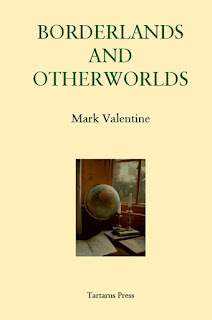Borderlands and Otherworlds & Sphinxes and Obelisks | review by Rafe McGregor
by Mark Valentine, Tartarus Press, limited edition hardback, £45.00, 17June 2025, ISBN 9781912586684
Sphinxes and Obelisks by Mark Valentine,Tartarus Press, paperback, £17.95, 12 November 2021, ISBN 9798764096322

I’ve been meaning to write a review of one of MarkValentine’s collections of essays for some time now, but when the last one wasreleased, I was right in the middle of my own six-part essay, ‘Weird FictionOld, New, and In-Between’ (which you can find here,if you’re interested). That was less than a year ago and the next one isalready available so I decided I’d better get on with it before I have to admitthat he can write essay collections faster than I can read and review them. Whileordering the recently released Borderlands and Otherworlds, I realisedI’d somehow managed to miss Sphinxes and Obelisks and ordered it inpaperback at the same time. This is review of both volumes.
Valentine is best known as a short story author, aneditor, and an essayist, but is also a biographer and poet. He has beenpublishing short stories and essays for more than four decades, although thesehave only relatively recently been collected in book form (In Violet Veils,in 1999, is – I think – the first) and more recently still (with – again, Ithink – The Collected Connoisseur, in 2010) made more widely availablein paperback. Much, perhaps even most, of Valentine’s output has been publishedby Tartarus Press, a highly successful independent publisher famous for theirlimited edition sewn hardbacks (usually 350 and signed, if publicationis not posthumous) with distinctive yellow dust wrappers and silk ribbonmarkers. If you are a collector as well as a reader, these are well worth theprice at £45, with free postage and packaging in the UK. While I’m on thesubject, Tartarus paperbacks have similar production values, but are probablyoverpriced at £17.95 (their Kindle editions appear to go for between £7 and£9; I prefer paper or audio books so I have no idea whether this isreasonable). Although I enjoyed Valentine’s The Collected Connoisseur,co-authored with his long term collaborator John Howard, a great deal, I havealways preferred his work as an essayist and editor to his short fiction (myreview of The Black Veil and Other Tales of Supernatural Sleuths, whichhe edited in 2008, was published in TQF24).
As an essayist, most websites list Valentine asspecialising in book collecting, but his scope is much wider than that andincludes undistinguished, forgotten, and obscure authors from the first half ofthe twentieth century and before, many of whom were writers of speculativefiction. Borderlands and Otherworlds is his sixth collection of essays published by Tartarus, thefirst five of which are all available in paperback: Haunted By Books(2015), A Country Still All Mystery (2017), A Wild Tumultory Library(2019), Sphinxes and Obelisks (2021), and The Thunderstorm Collectors(2024). I’d be exaggerating if I said every essay in every collection is worthreading or that one or more of the collections shouldn’t be missed byspeculative fiction fans, but I don’t regret the time or money spent on any ofthem. Rather than browsing their often diverse and always idiosyncratic tables of contents, I recommend watching thisinterview with Valentine, which gives a very good sense of the man, hisinterests, and even his prose style.
Sphinxes and Obelisks consists of 32essays, 10 of which have been previously published, and a substantiveintroduction. It is worth noting, for both volumes, that the periodicals inwhich the essays previously appeared have often either ceased publishing orwere privately issued, meaning that many readers are, like me, unlikely to haveencountered them before and that they are simply no longer available anywhereelse (both of which makes these collections all the more valuable). A summaryof each essay would not only be tedious to compile, but almost certainly fail to do the collection justice and my intention is to expand Valentine’sreadership, not reduce it, so I shall restrict commentary to those I enjoyedthe most. The one on my shortlist thatwill probably appeal the most widely is ‘The “Wonder Unlimited”: Hope Hodgson’sTales of Captain Gault’ (9 pages). William Hope Hodgson (1877-1918) is now recognisedas one of the original pioneers of theweird as a distinct genre within speculative fiction more generally and ispossibly best known for his serial occult detective, Thomas Carnacki (firstcollected in Carnacki, the Ghost-Finder in 1913), though he was alsothe author of The House on the Borderland (1908), The Night Land(1912), and various tales of the sea. Valentine discusses a group of thelatter, which featured the serial character Captain Gault and were some of Hodgson’smost commercially successful work, while reflecting on the curious decline ofthe nautical tale as a genre of its own. For me, the other highlights of thecollection are: ‘“Change Here for the Dark Age”: Edward Shanks’ The Peopleof the Ruins’ (12 pages), about a precursor to Robin Hardy’s The WickerMan (1973); ‘Sombre Gloom: The Macabre Thrillers of Riccardo Stephens’ (8pages), about an early mummy novel; ‘Cricket in Babylon’, about the(surprisingly many) varieties of what I’m going to call armchair cricket (6pages); ‘Three Literary Mysteries of the 1930s’ (6 pages), about three talentedauthors – Robert Stuart Christie, Petronella Elphinstone, and Seton Peacey –for whom almost no biographical information exists; and ‘Passages in the West’(8 pages), an autobiographical account of a book hunting expedition in the WestCountry.

Borderlands and Otherworlds also consistsof 32 essays, 8 of which have been previously published. My favourites are thefirst and last. In the former, ‘Borderlands and Otherworlds: Some SupernaturalFiction of the Early 1920s’ (17 pages), from which the collection takes itstitle, Valentine discusses the uncanny fiction of Edward Frederic (E.F.) Benson(1867-1940), Mary Amelia St Clair (May Sinclair, 1863-1946), Forrest Reid(1875-1947), Walter de la Mare (1873-1956), Lesley Garth (who was probablyLesley West Garth: born in 1900, married to William Ball in 1927, died in1988), and George Oliver Onions (1873-1961). This is Valentine at his mosttypical and at his best, unearthing hidden – or, more accurately, forgotten –treasures. I am assuming, of course, that, like me, most TQF readers will befamiliar with no more than half of these authors (Benson, De la Mare, andOnions in my case, although I have yet to read Benson). The last essay, ‘In theAttic’ (5 pages) is, as the title suggests, an (all-too-brief) rummage throughValentine’s attic, which is full of all the forgotten treasures his regularreaders will expect. My other highlights are: ‘At the House of Magic: MaryButts’ Modernist Novels of the Occult’ (6 pages), about Mary Franeis Butts(1890-1937), a collaborator of Aleister Crowley who was praised by T.S. Eliot; ‘Priestessof the Inner Light: The Magical Novels of Dion Fortune’ (11 pages), about VioletMary Firth (1890-1946), founder of the Fraternity of the Inner Light; ‘TheLast, Lost Novel of Phyllis Paul’ (4 pages), about a novelist who retains a cultfollowing in spite of next to nothing being known about her life (1903-1973); and‘The Serpent at Ashford Carbonell’ (3 pages), about a mystery encountered duringa book hunting expedition in the Welsh Marches.
So far, The Thunderstorm Collectors is my firstchoice of the six – I don’t recall a single essay where my attentiondrifted for even a moment – but Borderlands and Otherworlds is a closesecond. Regardless of precise preference, the same can be said of all the volumes: Valentine’sessays are simultaneously fun and fascinating, clever and chimerical, enlighteningand exquisite.



